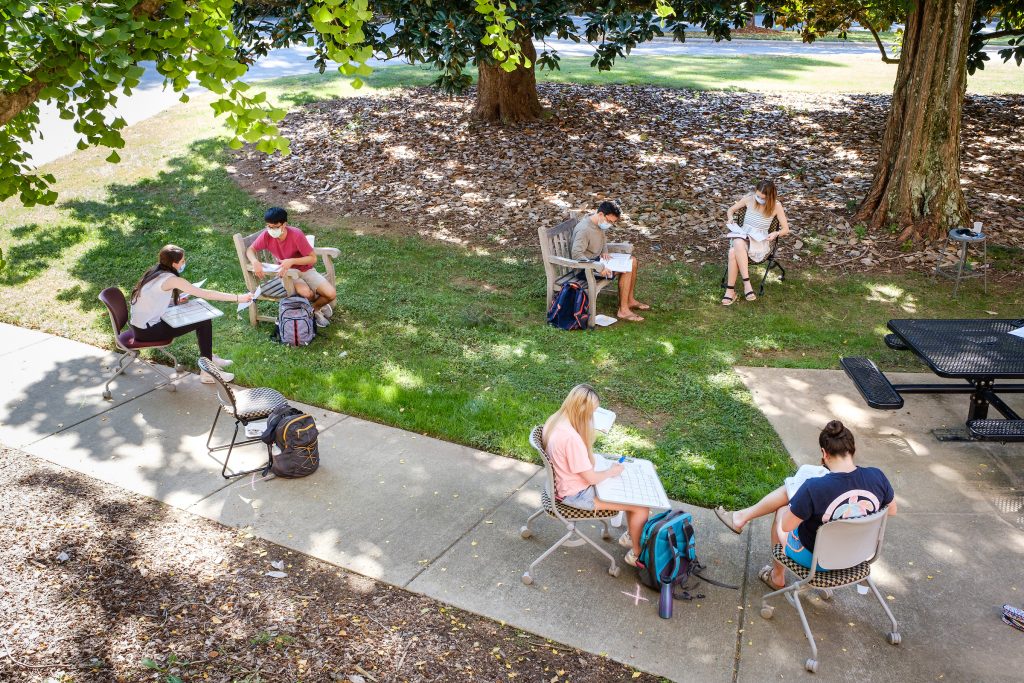Learning Activities in Blended and Online Courses
In real estate, the mantra is location, location, location. Location is central to property value. At Wake Forest, the mantra for teaching might be connection, connection, connection. Connection between students and their instructor; connection between classmates; and connection to the content of the course. Connection is central to the teacher-student relationships and engaged learning emphases of the Wake Forest experience. As we interpret the Fall 2020 survey data and look to it for guidance in Spring 2021, the lens of “connection” brings strategies for successful and engaging learning activities into focus. In this post, we highlight areas of convergence and divergence in the use and perceived engagement of learning activities and then distill the survey findings into seven recommendations.
Learning Activities in Blended Courses
The four most highly utilized activities in blended courses were centered around building student connection with classmates and content (Figure 40). Of these, whole-class in-person discussion (60%) and out of class group work (65%) were also reported as engaging (91%, 82%, Figure 41). Overall, students reported engaging most with activities that took place in-person. This is not surprising and affirms the universal desire for in-person togetherness, a return to normalcy, and hopefully, an appreciation for our approach to engaged, relational teaching. Text-based discussion boards were highly utilized but were associated with lower levels of student engagement. Recommendations later in this post offer suggestions that may lead to more engaging discussions.
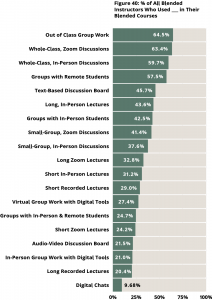
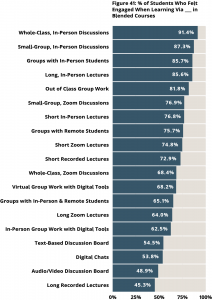
Learning Activities in Fully Online Courses
In fully online courses, the learning activities utilized by over 50% of faculty involved opportunities for students to connect with the content of the course while also connecting with their instructor and fellow classmates (Figure 42). Encouragingly, students reported that these highly utilized activities were engaging (Figure 43). Short lectures, recorded and live, were strategies used by approximately one-third of faculty, but were found engaging by most students (82% and 77% respectively). Short lectures may be a particularly important tool for student connection with content in fully online courses.
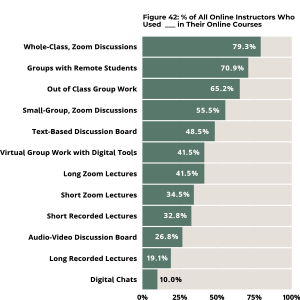
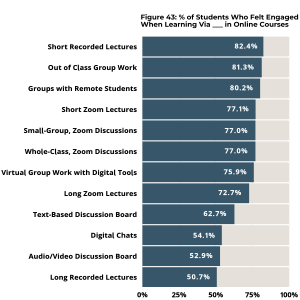
Recommended Learning Activities
Overall, the patterns that emerge from the Fall 2020 surveys for successful and engaging learning activities center around three themes: a desire to create and participate in learning experiences centered around collective, collaborative construction of knowledge; opportunities for human connection; and utilization of retrievable, reviewable content artifacts. Building from these themes, we offer the following recommendations for Spring 2021 classes and beyond.
1: Create Short Recorded Videos
Short recorded lectures help students connect more deeply with the course content, and feel more prepared to engage with their instructor and classmates during synchronous sessions. Nearly 20% of all open-ended responses on the student survey identified recorded lectures as an online activity or assignment that helped them learn. When asked about technologies to continue using in the future, 48% of all student respondents indicated recorded lectures. These student responses highlight this finding:
- Pre-recorded lectures [were an online activity that helped me learn]. I was able to go back if there was something I didn’t quite grasp the first time. I could also pause and take notes as I went along. For material I felt I knew well I could play it back at a faster speed but could still pause it if I needed to.
- I really enjoyed the short VoiceThread lecture videos that had short questions throughout. These kept me engaged in the material.
Tip 1: Make your short recorded videos interactive by embedding questions and prompts.
13% of Wake Forest faculty almost always used interactive recordings, and those that did reported that students were more prepared and more engaged in the subsequent synchronous class sessions. Inserting questions and prompts is also highly recommended for live lectures, whether in-person or over Zoom. Polling questions, discussion prompts, and reflection opportunities promote comprehension checks, application, and an opportunity to reset attention. One faculty who used this shared:
- I had pre-recorded video lectures with embedded quizzes where the students could retake for the full points throughout the week…. I was surprised that the students claimed to like these videos. The interactive quizzes, buildup of low-pressure grade points, and the ability to replay seem to be what they liked.
Kaltura is a video-hosting platform that integrates with Canvas and makes it very easy to embed questions and prompts into a recorded video. Other options include VoiceThreads and creating submission spaces within Canvas.
2: Bridge Asynchronous and Synchronous Activities
Intentionally and explicitly connecting assigned asynchronous content with activities in synchronous class sessions can help students appreciate the value of the asynchronous assignments, increase motivation to do the work, and improve participation in synchronous sessions. Both faculty and students noted these connections:
- I recorded 6-8-minute videos for students to watch before class, posted questions on google docs that would guide our in-class discussions, and had students post a quote and a question about the reading. All this prep before class meant they were more prepared than in my previous semesters to have a meaningful discussion…I felt that the combination of in-person and online asynch work made for one of the most successful courses I have taught in years. (Faculty response)
- I like how my teachers provided lecture videos to watch before class because then I was able to more readily participate in class and gain a deeper understanding of the topic. (Student response)
Tip 2: Use asynchronous work as the basis for small group discussions at the beginning of class sessions.
Small group activities centered around asynchronous content at the beginning of a class session gives students an opportunity to “dust off the cobwebs”, gain confidence in their thinking, and identify points of consensus and areas needing clarification. This can also serve to focus student attention and prepare them for lectures or discussions that will follow. Two faculty responses illustrate this:
- Bridge exercises from video to scheduled class involving both individual artifacts and team-based brainstorming reported in the first 15 minutes of class [was a learning activity I found beneficial].
- I put 1 or 2 “check in” problems throughout my pre-recorded lectures, and students submitted pictures of their work … we’d start class with a discussion of these problems. I was really happy with how this worked out. I think it helped motivate students to watch the lecture, and they were very prepared for our in-person discussion. I’ve never had so much participation during in-person classes!
3: Assign Collaborative Activities and Assignments
Close to 30% of all the open-ended student responses expressed appreciation for activities that allowed them to engage with their peers. Working in groups — out of class, in live synchronous sessions, and in-person — felt engaging to a significant majority of students (Figures 41, 43). Asynchronous collaborative activities included Fishbowls, StoryMaps, Jigsaws, Google docs, Peer Reviews, Jamboards, and discussion recordings. Synchronous collaborative activities included many of these same strategies within the space of breakout rooms. While there are strong feelings about breakout rooms, it’s worth noting that 10% of all the open-ended student responses reflected appreciation for breakout rooms. Students were very positive about their collaborative experiences:
- Break out rooms with other students [were an activity that helped me learn]. It was easier to talk and learn from them.
- I was given an assignment where …my group who met on zoom worked together to fill out parts of a chart … while other groups edited other parts of the chart either at the same or different times. We were able to work at our own pace, and talk about the material on our own and the finished product was very interesting as it provided us with an important overview of the material.
One faculty member who posted lecture content asynchronously and then used synchronous class sessions for collaborative problem solving shared this:
- Students broke up into groups of 5 (in a Zoom breakout room) and each chose an assigned role (recorder, questioner, explainer, etc.) … I believe this part of the course was the most impactful. I honestly think my students learned more this semester than in previous semesters because of the amount of work they were doing themselves (rather than listening to me).
Tip 3: Make sure you provide clear instructions and expectations to ensure higher quality work.
Both faculty and students highlighted the importance of clarity and structure for activities and assignments:
- I found it very helpful to create 2-3 identical google docs with comprehension/reflection questions on them then sharing each with a ” group” of students –and pasting the link into Canvas …This seemed like a good way to imitate group work in class that we could not quite do (even face-to-face). I added comments/corrections in a different color. We often discussed the questions orally as an entire class on Zoom –since some groups responded differently than others. (Faculty response)
- __ paper was a group assignment. __ provided a plethora of context and direction (modules, documents, etc.) that really equipped our team with the necessary instruction to build a thorough deliverable on our own time. (Student response)
4: Require Video, Audio, or Text-Based Artifacts
Artifacts or deliverables resulting from individual and collaborative learning activities support learning and engage students by promoting accountability, creating a foundation for discussion, and archiving content to help with later studying. Giving students some agency in the types of artifacts they produce can increase motivation as well. These responses highlight the potential of learning artifacts to connect students with course content and their classmates:
- One of my professors often assigned us small projects in which we were asked to create a short video or presentation with audio recording about a topic of our choosing from a list of topics from our professor based on the current material. I found these exercises very engaging because I was able to be creative and prefer to express my knowledge through speaking. (Student response)
- My students loved their recorded fishbowl conversations. I had them assigned to small groups for the entire term. About 5-6 times, they had to meet up on Zoom and record a conversation about the week’s materials, using a prompt and/or a worksheet. They submitted their discussion recording and, when assigned, their group worksheet or write up. They loved it. It was a much better stand-in for interaction than discussion boards. (Faculty response)
Tip 4: Have students post and share their work so that others can learn from it.
Both faculty and students noted that being able to share and respond to others helped greatly with connection to course content and classmates. Two specific technologies were frequently highlighted, VoiceThread and Hypothes.is. Students indicated a great deal of appreciation for how sharing their work with others improved their learning:
- …Each group had a shared Google Doc where we wrote up short homework assignments and commented on each other’s work. It was really helpful to be able to see and share in the work of my peers, especially when it came time to study for exams. We all improved and learned more about the texts we were studying by seeing it through perspectives other than our own.
- …each week we got to choose a chapter from the textbook and then write a blog on it … At the end of the week, we would read our classmates’ blogs and give them feedback about what value we thought they brought. These were helpful because they helped us to apply our learning and made the class fun. I looked forward to our small group discussions and feedback and felt like I really knew my classmates despite being all online.
- I would say the most helpful/most-engaging online activities were through Voicethread. Students can publicly comment questions on lecture content, the professor can respond, and all students can see and benefit from that process. It is also easy to engage and have discussions on Voicethread.
5: Use Metacognitive Prompts
Faculty reported success when they explicitly and intentionally asked students to reflect on their learning. Responses from faculty suggest that encouraging self-reflection in online and blended courses may help students achieve more connection with the course content:
- …assigned very short post-class discussion post assignments, either for the whole class or small groups. Again, this produced more meta-cognitive reflection than I usually see in students.
- I also utilized Flipgrid for metacognitive reflection at the end of each module, which allowed students to see and learn from each other, as well as articulate their own learning.
Tip 5: Use prompts that help personalize course content or apply it to real-world scenarios and future goals.
- I had them write frequent, short (100 word max) ‘reflections’, connecting lecture topics to their current or future goals.
- We did a lot more of having students assess their own learning – asking them pointed questions about how a lecture or reading or assignment changed how/what they thought and how they would use it going forward.
6: Invite Guest Speakers to Live Sessions
Faculty highlighted the effectiveness of guest speakers and panels in their synchronous sessions. Guests could include professional colleagues from other institutions; practitioners in the field; or community stakeholders in a topic. Anecdotal evidence suggests guest speakers created variety and energy in the class:
- The students enjoyed when I brought in guests on-line to teach particular areas or to have panel discussions.
- I also used Zoom to bring in about a half dozen guest speakers for each class. These sessions kept students engaged and took advantage of the Zoom technology, which allowed me to bring in speakers from around the country and one international speaker.
Tip 6: Create assignments to help students prepare for guests.
Examples of assignments could include developing interview questions; creating a timeline of a scholar’s career; contextualizing a publication within a larger disciplinary conversation; and identifying the positionality of the guests and the perspectives that are missing.
7: Create Opportunities for In-Person Active Learning
Active learning strategies are ideal for cultivating connections between students and with course content, but are more complicated to implement in socially-distanced spaces. Approximately 40% of faculty reported utilizing in-person small groups for collaborative activities or discussions and over 75% of students reported feeling engaged in these learning activities (Figure 40, 41). Two specific implementation strategies mentioned were use of rolling and personal whiteboards and teaching outside.
Tip 7: Low tech tools like whiteboards and high tech tools like the G-suite can enable collaborative learning in socially-distanced classrooms.
There are questions and concerns about the practical implementation and safety of in-person group activities. To be sure, distancing, sound levels, and room configurations can make it complicated. Some solutions involve low-tech tools and physical movement while others utilize digital tools. 27% of faculty teaching blended courses reported using digital tools for in-person group activities. For those faculty wanting to integrate more active learning into in-person socially-distanced class sessions, here are some resources: a crowdsourced spreadsheet curated by Jennifer Bumgartner at LSU; blog posts from the Vanderbilt University, University of South Florida, and Carnegie Mellon University teaching centers. Additionally, the College has indoor spaces available by reservation for supplementary in-person socially-distanced academic uses such as film screenings, language conversation, small group workshops, and office hours. When requesting supplementary space directly supporting a course, include the course number and the term “Supplementary Space” in the reservation title.
Subscribe
Receive CAT blog posts in your inbox.

